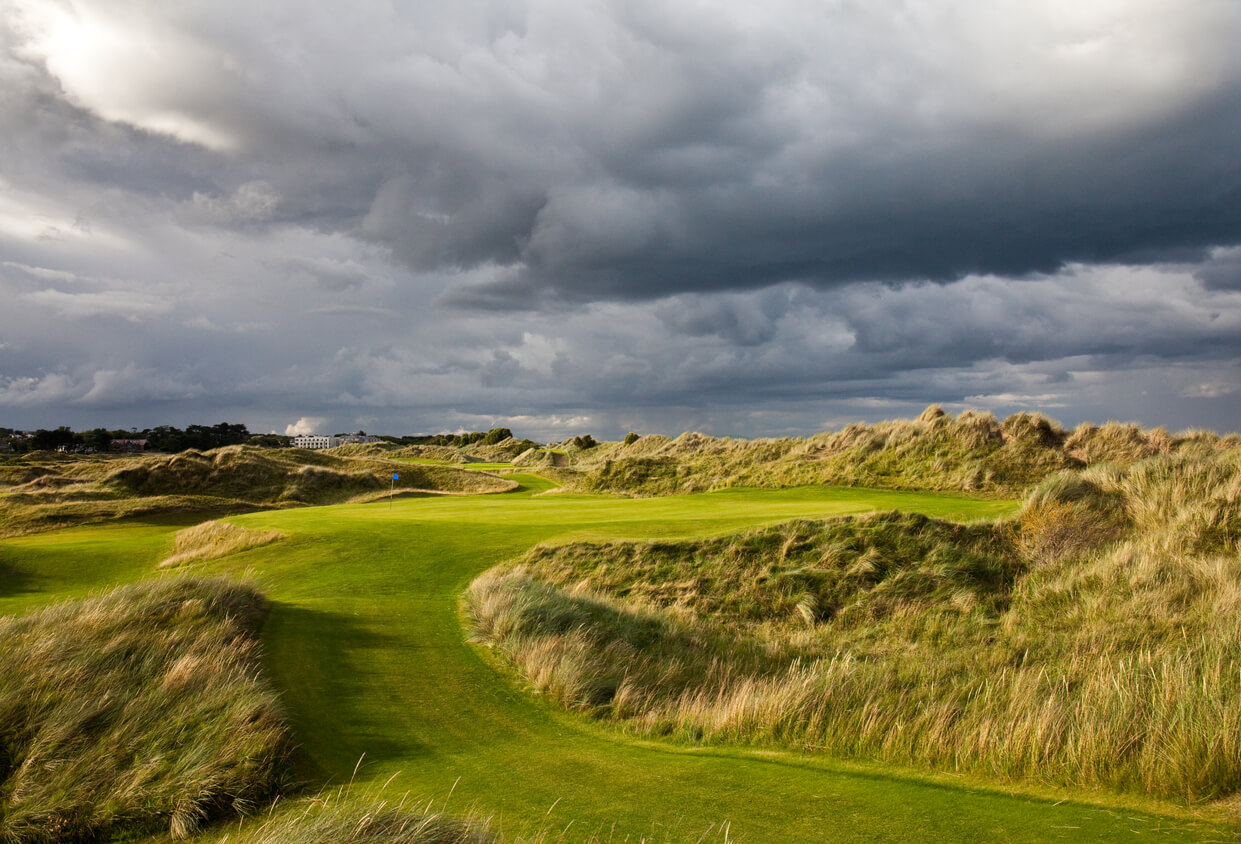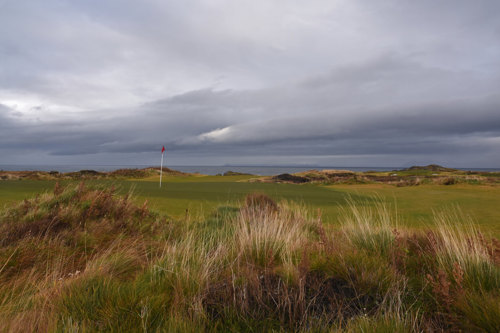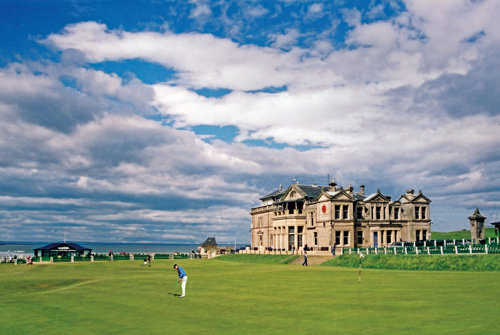What is a links golf course?
17 July 2025

If you’ve never played on one, you’ve likely heard them mentioned. You might’ve even thought to yourself, what is a links golf course?
Picture this: the sun is shining, the wind is flowing through your hair, you can taste the salty air, and what’s more, you’ve got a club in your hand and 18 holes to play. That, in essence, is a links golf course, and you simply have to try one.
But before you do, this guide will tell you everything you need to know about links courses. We’ll define what we mean by a links course in golf and look at some of the best to play in the UK.
What is a links course in golf?
A links course is a golf course found in a coastal area. They’re typically 18 holes, but this isn’t always the case. Regardless, they offer challenges that differ from your average course, thanks to their exposure to those elements which characterise the shoreline.
Furthermore, links courses are entirely natural and defined by the sandy soil underfoot. This is known as linksland and is created by wind and sea erosion. Because of this, links courses can be more varied and unpredictable than other courses. You might also find bumps and slopes that make playing the game just that little bit harder. However, it’s all worth it when you can look up at the glorious ocean views.
Links courses also generally use the traditional out-and-in route, in that the first nine holes take you away from the clubhouse and the second nine bring you back.
The Links Association states that there are only 247 true links courses in the world, making them incredibly rare and all the more worthwhile to try.
The history of links courses

Links golf courses have existed for around 600 years and originated in Scotland. The word ‘links’ comes from the Old English word ‘hlinc’, which means ‘rising ground’ or ‘ridge’. It refers to sand dunes and sometimes parkland in a coastal location.
Because links courses are so old, their constructions are all natural and not manmade. Back in the 15th century, creating a course by hand was extremely difficult and time-consuming, so it made more sense to follow the natural shape of the land. This means no two links courses are the same.
The Open Championship is famous for using links courses and has done so since its inception in 1860 at Prestwick Golf Club.
What are the differences when playing on a links course?
There are plenty of challenges unique to links courses that golfers don’t have to face on typical courses.
Terrain, as mentioned, is one big factor in this. The turf underfoot will likely be more uneven than you’d usually expect. That said, linksland is still a firm and more than playable surface, and one which drains particularly well.
In fact, the terrain is your friend when it comes to links courses for one big reason: the wind. The lack of trees and other manmade structures means you’re at the mercy of the wind, so your shots must differ. Using a wedge with a high loft is perhaps ill-advised, unless you’re trying to escape a bunker (and, with them being designed by Mother Nature, they can be particularly nasty on links courses) because they’re all about getting airtime, which will make your shots much more unpredictable in the wind.
Instead, you’ll have to use a club which keeps the ball closer to the ground: a 7-iron or a wedge with a lower loft would be ideal. Techniques like the bump and run, whereby these clubs are almost used like a putter, can be very beneficial when it comes to mitigating the effects of the wind.
The weather doesn’t just affect how you play. If you’ve ever visited a Scottish beach (where many links courses are located), you’ll know they can get quite wet and chilly. In fact, the Scottish climate is well-known for its rapid changes. You’ll have to dress for the occasion and prepare for the elements: a moisture-wicking base layer, an additional warmer layer, and a raincoat are all necessities throughout much of the year.
Where to find links courses
There are more than 38,000 golf courses in the world, and only 247 are considered links courses. Of those few, 211 are in the UK and Ireland. Scotland has the most with 85, Ireland has 58, England has 53, and Wales has 15.
Links courses are very scarce outside of the British Isles. For example, only five of the remaining 36 are in the US. This rarity is what makes links courses a popular bucket list item for golfers, especially for those based outside of the UK.
The most famous links courses in the UK

As we’ve already mentioned, the vast majority of links courses are located in the UK, and they include some of the most famous courses in all of the golf world—some of which you might not have even realised were links courses at all.
Seven of the most famous links include:
1. Royal Aberdeen (Scotland)
Founded in 1780, Royal Aberdeen Golf Club is one of the oldest golfing institutions in the world. Its course is famous for its difficulty, particularly in the wind, but remains a proper old school course with stunning views.
2. Royal St. George's (England)
Each hole in this course, famous for its use in The Open Championship, is a unique challenge. No one is more notable or difficult than the next, and like most links courses, it’s a stunning location for a round of golf.
3. Royal Porthcawl (Wales)
This is often regarded as the very best golf course in Wales, and it’s easy to see why. Royal Porthcawl offers perhaps the most picturesque setting of any course in the country, particularly in the middle of the course where the ground is elevated.
4. Royal Lytham & St. Annes (England)
While it doesn’t boast seaside views in quite the same way as other links courses, with residential areas and railway tracks surrounding much of the course at Royal Lytham & St. Annes, it’s still a classic course with plenty of challenges.
5. Royal Portrush (Northern Ireland)
The Dunluce course at Royal Portrush is generally considered one of the best links courses in Northern Ireland, and it’s in the conversation for the whole UK, too. Designed by the legendary Harry Colt, you’d struggle to find any flaws with this stunning course.
6. Royal County Down (Northern Ireland)
The same can be said for the Championship Course at Royal County Down, which is beautiful not only in its terrain, but also in its views, which encompass the Mountains of Mourne along with the typical seafront.
7. St. Andrews (Scotland)
Fife’s legendary St. Andrews, particularly the Old Course, is about as good as it gets for links golf. While the course isn’t the most challenging, that’s not really the point: this is the Home of Golf, and a must-visit for any fanatic.
So, if you’ve never played on a links course before, consider this your sign to visit one. This is classic golf, played in its original form, and it might just be an experience you never forget.
Specialist golf insurance with Golf Care
Heading out to play a links course? You may want to consider protecting yourself and your gear with specialist golf insurance first.
With Golf Care, policies include Equipment Cover up to £7,500, Public Liability of up to £10m, and Personal Accident Cover up to £50,000. Get a quote online today.
Please note the information provided on this page should not be taken as advice and has been written as a matter of opinion. For more on insurance cover and policy wording, see our homepage.
